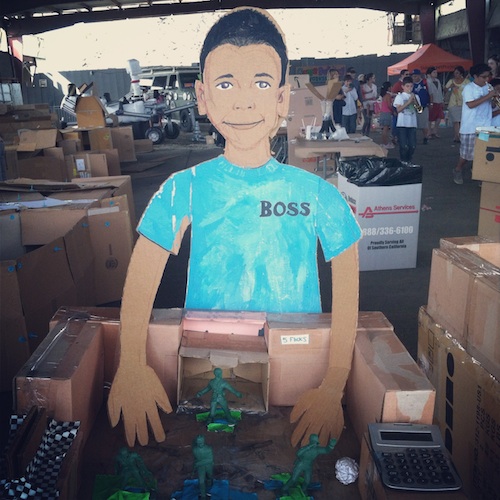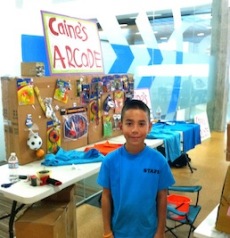![]() This year’s Sandbox Summit, hosted by MIT on April 17th and 18th, ranged from the very low tech (a live action card game) to very high tech FlickerLab’s new live (animation studio). Despite the diversity of participants, there was one recurring theme: kids need and expect experiences rather than products. And for producers and developers, that requires new ways of synthesizing ideas.
This year’s Sandbox Summit, hosted by MIT on April 17th and 18th, ranged from the very low tech (a live action card game) to very high tech FlickerLab’s new live (animation studio). Despite the diversity of participants, there was one recurring theme: kids need and expect experiences rather than products. And for producers and developers, that requires new ways of synthesizing ideas.
The first keynote speaker and CEO of Callaway Digital Arts, Rex Ishibashi, argued that while the ecosystem of kids’ media is complete (omnipresent devices, ubiquitous connectivity, cost-effective content development), development is tough because 21st century kids and their digitally equipped parents demand a complex experience. To achieve that level of full engagement, he said that diverse teams of producers and developers need great chemistry, the ability to forget the lessons that no longer apply and validation through user testing. Russell Hampton, President of Disney Publishing Worldwide, also noted the challenge of bringing together “divergent cultures” of a staff in the digital publishing space. He explained how Disney’s e-books are their most feature-rich products (and require significant investment to reach multiple platforms in multiple languages) but have the most constrained price points.
Allison Arling, Senior Director of Strategic Innovation at The Intelligence Group, shared the latest data on how today’s youth see their favorite mobile device less as a tool and more as a relationship. This leads to changes in the way we typically think about loyalty, engagement and connection. She characterized Generation Z (kids aged 7 to 13) as growing up in a “flatter world” where they expect “digital fluid integration.” Nickelodeon’s 2011 Mobile Study revealed how some children ages 6 to 11 even create their own personal spaces (bunkers made of blankets and pillows) in which to experience an average of 24 different apps. Jane Gould, SVP of Consumer Insights at Nick, believes future mobile usage patterns will be determined by preschoolers.
Alex Games, Ph.D., member of the JGCC’s own Games and Learning Publishing Council and Education Design Director at Microsoft, described the informal learning landscape as “a dam that’s about to break”–aided by the semantic cloud, peer-to-peer communication, scalable distribution models and social media business models. But he also raised concerns about the serious challenges of accessibility, standards, assessment and institutional barriers like bureaucracy in schools.
He wasn’t the only presenter who voiced more caution than celebration of the current digital sandbox. Heather Chaplin, Assistant Professor of Journalism at The New School, reflected on the expression “Show me the games of your children and I’ll show you the next hundred years,” and warned of taking rationality too far. If most games are a reflection of a systems way of thinking, will that result in a deficit of empathy? The audience discussed whether role-playing games or games with a social component might foster empathy. Colleen Macklin, Associate Professor in the School of Art, Media and Technology at Parsons, questioned the intelligence of “smart phones,” and used the example of Caine’s Arcade to argue for fewer apps, more cardboard.
In the final presentation of the Summit, game designer Eric Zimmerman described a rising tide against the push for proof that games teach and the view of games as literal instruments, rather than rich experiences and creative forms in their own right. He used art education as a model for thinking about games and learning, and described his vision for a “Ludic Century” in which games are the defining cultural form.
While digital games and mobile devices are ubiquitous and offer at least as much potential as books or television, Sandbox Summit attendees appeared daunted by the challenges they face. The most provocative presentations hearkened back to the simplicity and creativity of playing in the sandbox-an environment without the developmental, production and policy complexities of kids’ digital experiences.
Watch videos of the presentations at the 2012 Sandbox Summit on YouTube, courtesy of Scott Traylor at 360kid.org.



